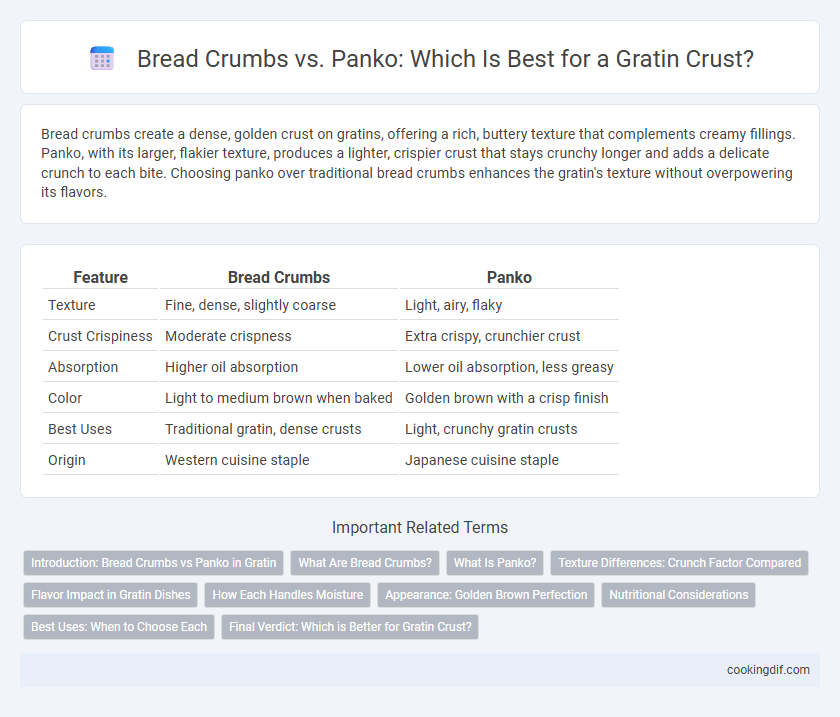Bread crumbs create a dense, golden crust on gratins, offering a rich, buttery texture that complements creamy fillings. Panko, with its larger, flakier texture, produces a lighter, crispier crust that stays crunchy longer and adds a delicate crunch to each bite. Choosing panko over traditional bread crumbs enhances the gratin's texture without overpowering its flavors.
Table of Comparison
| Feature | Bread Crumbs | Panko |
|---|---|---|
| Texture | Fine, dense, slightly coarse | Light, airy, flaky |
| Crust Crispiness | Moderate crispness | Extra crispy, crunchier crust |
| Absorption | Higher oil absorption | Lower oil absorption, less greasy |
| Color | Light to medium brown when baked | Golden brown with a crisp finish |
| Best Uses | Traditional gratin, dense crusts | Light, crunchy gratin crusts |
| Origin | Western cuisine staple | Japanese cuisine staple |
Introduction: Bread Crumbs vs Panko in Gratin
Bread crumbs and panko both serve as popular crust options for gratin, providing texture and flavor contrast to the creamy interior. Traditional bread crumbs offer a fine, dense coating that crisps to a golden brown, while panko, made from crustless white bread, produces a lighter, airier, and crunchier crust. Choosing between bread crumbs and panko impacts the gratin's final texture and mouthfeel, with panko often preferred for a crispier, less oily topping.
What Are Bread Crumbs?
Bread crumbs are finely crushed dried bread pieces commonly used to create a crispy crust on gratins, providing a dense, uniform texture and a slightly nutty flavor. They absorb butter or oil well, resulting in a golden-brown finish that enhances both taste and appearance. Traditional bread crumbs differ from panko by being finer and more compact, which yields a firmer, less airy crust in gratin dishes.
What Is Panko?
Panko is a type of Japanese bread crumb known for its light, airy texture and larger, irregular flakes that create an exceptionally crispy crust in gratin dishes. Unlike traditional bread crumbs, panko is made from crustless white bread, resulting in a crispier, less oily coating that enhances the gratin's golden topping. Its superior crunch and ability to absorb less oil make panko the preferred choice for achieving a crunchy, yet delicate gratin crust.
Texture Differences: Crunch Factor Compared
Traditional bread crumbs create a denser, finer crust with a moderate crunch when baked on gratin dishes. Panko, made from crustless white bread, produces a lighter, airier texture that results in an exceptionally crisp and flaky topping. The larger, irregular flakes of panko enhance crunch factor significantly, making it ideal for gratin recipes requiring a distinct, satisfying crispness.
Flavor Impact in Gratin Dishes
Bread crumbs create a denser, slightly buttery crust in gratin dishes, enhancing richness and depth of flavor. Panko offers a lighter, crispier texture with a more neutral taste, allowing the creamy layers to shine without overpowering. Choosing between bread crumbs and panko depends on whether you prioritize a robust, golden crust or a delicate, airy crunch.
How Each Handles Moisture
Panko breadcrumbs create a lighter, airier crust due to their coarser texture and larger flakes, which allow better moisture evaporation during baking. Regular bread crumbs absorb more moisture, resulting in a denser, softer crust that may become soggy if excess liquid is present. Choosing panko over traditional bread crumbs enhances crispiness in gratin dishes by preventing moisture retention on the surface.
Appearance: Golden Brown Perfection
Panko crumbs create a lighter, crispier crust with an airy texture, resulting in a golden brown perfection that elevates the gratin's appearance. Traditional bread crumbs provide a denser, more compact crust, producing a deeper, richly browned finish. The choice between panko and bread crumbs directly influences the gratin's visual appeal and mouthfeel.
Nutritional Considerations
Bread crumbs and panko differ significantly in nutritional content, with panko typically containing fewer calories and less fat due to its lighter, airier texture. Standard bread crumbs often have higher sodium levels and may include added preservatives, impacting overall health considerations. Choosing panko can contribute to a lower-calorie crust without sacrificing the desired crispy texture in gratin recipes.
Best Uses: When to Choose Each
Traditional bread crumbs create a dense, golden crust ideal for classic gratins where a uniform, slightly chewy texture is desired. Panko offers a lighter, crispier crust perfect for gratins featuring delicate vegetables or seafood, adding a crunchy contrast without overpowering the dish. Choose traditional bread crumbs for a richer, heartier topping and panko when a crunchy, airy texture complements the ingredients best.
Final Verdict: Which is Better for Gratin Crust?
Panko bread crumbs create a lighter, crispier gratin crust due to their larger, flakier texture that browns evenly without becoming soggy. Traditional bread crumbs offer a denser, more compact crust with a richer, buttery flavor but can sometimes turn mushy under creamy gratin sauces. For a perfectly crunchy and golden gratin topping, panko is generally the superior choice, enhancing both texture and visual appeal.
Bread Crumbs vs Panko for crust Infographic

 cookingdif.com
cookingdif.com